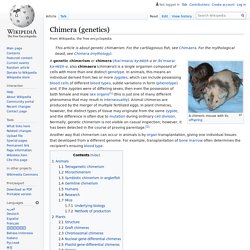

Students Build the First Eukaryotic Chromosome from Scratch. List of genetic disorders. The following is a list of genetic disorders and if known, causal type of mutation and the chromosome involved.

The list of human genes includes genes not listed here, which also affect predisposition toward certain diseases. More common disorders. Scientists identify depression and anxiety biomarker in youths. Scientists have discovered a cognitive biomarker – a biological indicator of a disease – for young adolescents who are at high risk of developing depression and anxiety.

Their findings were published today, 28 November, in the journal PLOS ONE. The test for the unique cognitive biomarker, which can be done on a computer, could be used as an inexpensive tool to screen adolescents for common emotional mental illnesses. As the cognitive biomarker may appear prior to the symptoms of depression and anxiety, early intervention (which has proven to be one of the most effective ways of combatting mental illness) could then be initiated.
For the study, 15-18 year old participants underwent genetic testing and environmental assessment, an exercise which would currently be too expensive and take too long to use as a widespread method of screening. The adolescents were then given a computer test to gauge how they process emotional information. Mosaic (genetics) Different types of mosaicism exist, such as gonadal mosaicism (restricted to the gametes) or somatic mosaicism.

Somatic mosaicism occurs when the somatic cells of the body are of more than one genotype. In the more common mosaics, different genotypes arise from a single fertilized egg cell, due to mitotic errors at first or later cleavages. Chimera (genetics) Single organism composed of two or more different populations of genetically distinct cells.

Extraordinary gene transfer between cells observed. Back to all News & Events 07 January 2015, Cancer A team led by Professor Mike Berridge from the Malaghan Institute has become the first in the world to demonstrate mitochondrial DNA movement between cells in an animal tumour.

Their paper was published today in the leading biological journal Cell Metabolism. The research lays important groundwork for understanding human diseases other than cancer, since defective mitochondrial DNA is known to account for around 200 diseases and is implicated in many more. It could also usher in a new field where synthetic mitochondrial DNA is custom-designed to replace defective genes. In mouse models of breast cancer and melanoma that had had their mitochondrial DNA removed, replacement DNA was acquired from surrounding normal mouse tissue.
Drug made in Ireland shuts down the extra chromosome cause of Down Syndrome. Researchers at the University of Massachusetts have shown that it is possible to shut down the extra chromosome that causes the developmental problems and intellectual disabilities in people with Down syndrome Photo by: Google Images A new drug manufactured by the Elan Corporation in Ireland that could be used to treat Down Syndrome and the medical problems that accompany it, will soon be tested by the Down Syndrome Program at Massachusetts General Hospital.

According to the Boston Globe researchers at the University of Massachusetts have shown that it is possible to do what had once seemed unthinkable, to shut down the extra chromosome that causes the developmental problems and intellectual disabilities in people with Down syndrome. Atavism. Early embryos of various species display some ancestral feature, like the tail on this human fetus.

These features normally disappear in later development, but it may not happen if the animal has an atavism.[1] Atavism is the tendency to revert to ancestral type. In biology, an atavism is an evolutionary throwback, such as traits reappearing which had disappeared generations before.[2] Atavisms can occur in several ways. One way is when genes for previously existing phenotypical features are preserved in DNA, and these become expressed through a mutation that either knock out the overriding genes for the new traits or make the old traits override the new one. Down syndrome. Antibiotics that target mitochondria effectively eradicate cancer stem cells, across multiple tumor types: Treating cancer like an infectious disease. Rebecca Lamb1,2,*, Bela Ozsvari1,2,*, Camilla L.

Lisanti3,**, Herbert B. Tanowitz4, Anthony Howell1,2, Ubaldo E. Sperm RNA carries marks of trauma. Tiripero/iStock/Thinkstock Mice exposed to stress have male offspring that show depressive behaviour across three generations.

Far From ‘Junk,’ DNA Dark Matter Proves Crucial to Health. Vitiligo. Vitiligo /ˌvɪtɨˈlaɪɡoʊ/ is a condition that causes depigmentation of parts of the skin.

It occurs when melanocytes, the cells responsible for skin pigmentation, die or are unable to function. The cause of vitiligo is unknown, but research suggests that it may arise from autoimmune, genetic, oxidative stress, neural, or viral causes.[1] The incidence worldwide is less than 1%.[2] There are two main types of vitiligo: idiopathic and chemical.[3] Most vitiligo is idiopathic, however in cases where it is triggered by skin bleaching or other substances, it is said to be chemical. Signs and symptoms[edit] Vitiligo on lighter skin Vitiligo on darker skin Cause[edit] Non-segmental[edit]
Learn.Genetics™ List of organisms by chromosome count. This page lists the numbers of chromosomes in various plants, animals, protists, and other living organisms, given as the diploid number (2n). This is not a comprehensive list, but instead should be seen as a cross-section of different groups. See also[edit] Chromosome References[edit] Jump up ^ Gerardus J. External links/sources[edit]